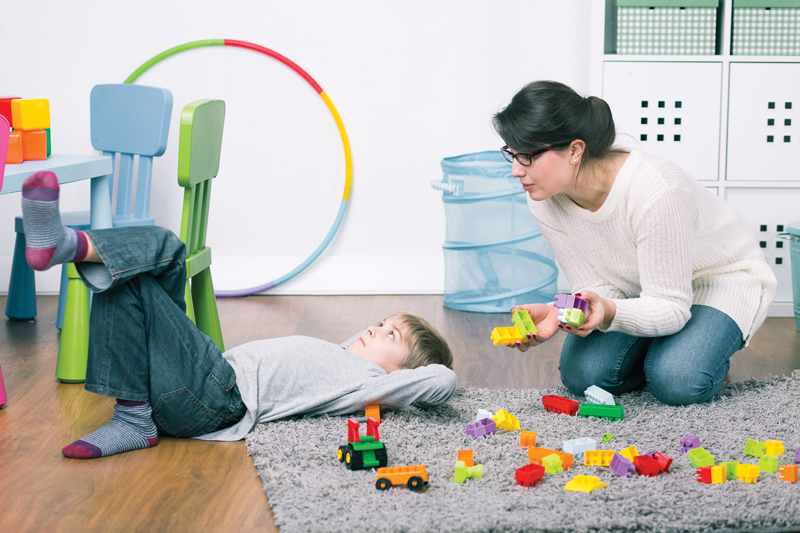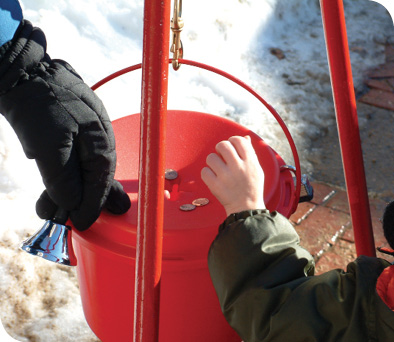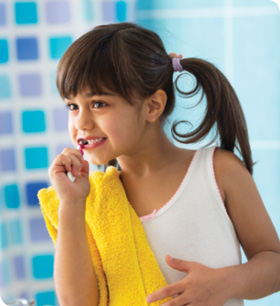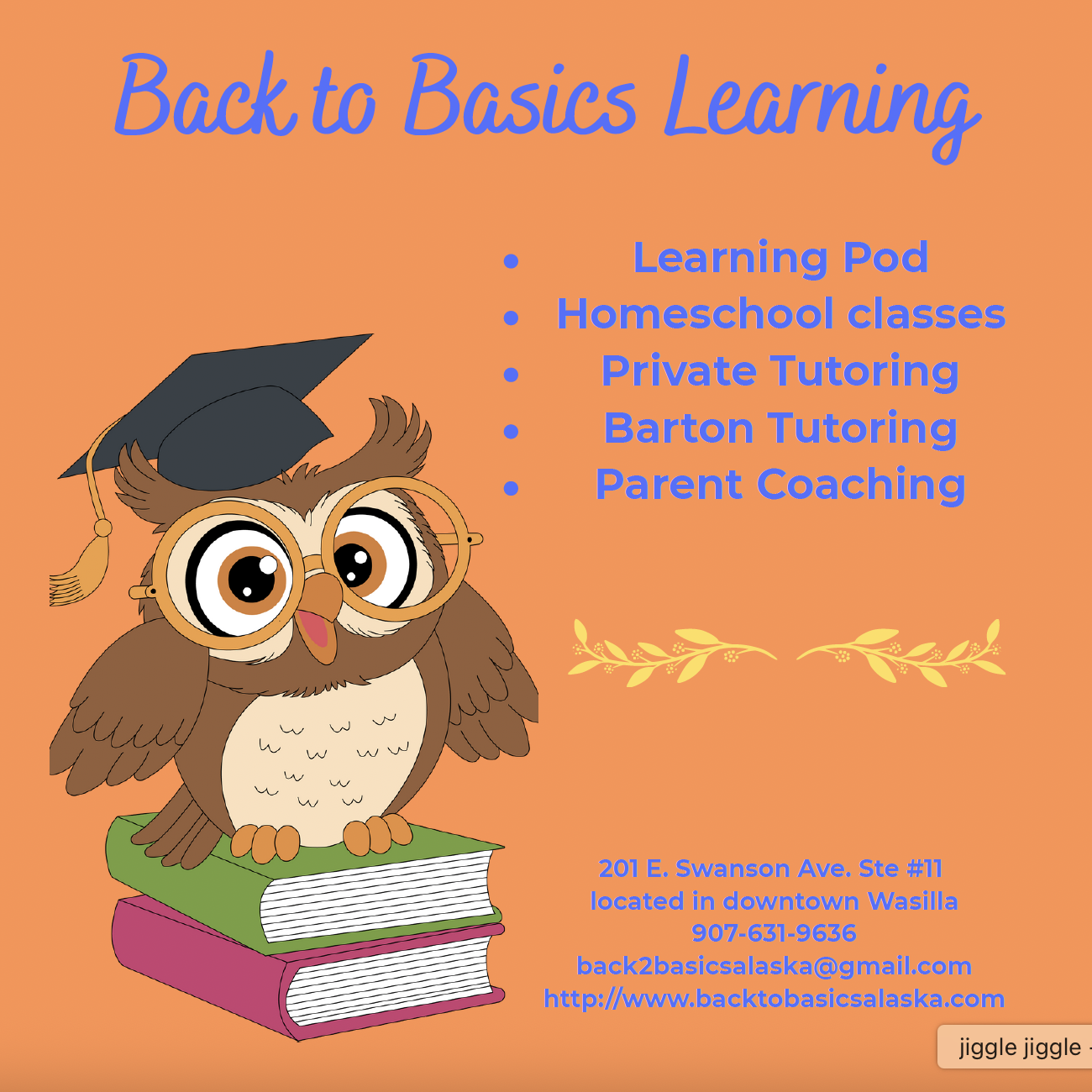ask the expert
the middle years
Quick Links:

How do I keep my 5- and 8-year-old entertained indoors when they can’t play outside, like on very cold or rainy days?
Make no mistake, I’m an advocate of going outside, no matter the weather. But some days we hunker down indoors, and that’s when I pull out the cookbooks. There are a lot of skills to be learned through cooking: food safety, following directions, measuring (math!), and enjoying the end result together. Kids in the early-elementary years are at the perfect age to learn basic kitchen smarts, and cooking is a fun way to bring these lessons to life. I like to use Alaska ingredients as often as possible, and turn to the Alaska Seafood Marketing Institute (alaskaseafood.org) and the UAF Cooperative Extension Service (cespubs.uaf.edu/publications/?&s=*&pt=*&cat=4) for a ton of recipe ideas using items sourced from right here at home. Plus, kids are proud to serve the whole family a meal or snack they made by themselves, start to finish.
This is also an excellent opportunity to begin discussions about kitchen safety, which runs the gamut from learning knife skills to protecting oneself from food-borne illnesses and bacteria. Assign your child a smaller knife such as used for paring, and practice cutting on a solid surface with a food item that is simple, like celery or apple slices.
When my sons were young, we discovered a love of baking breads when we had ample time to discuss the process. Yeast-based breads are fabulous, edible tools for learning math and science, especially chemistry. Talk about yeast and its almost magical ability to activate in warm water and cause bread to rise. Practice measuring in exact proportions, and explain how a bit too much or too little flour, sugar or milk can cause the whole baking project to change.
Erin Kirkland is an Alaska family travel journalist, author, and publisher of akonthego.com, a website dedicated to kid-friendly activities and destinations around the state.

Our fourth-grader seems really anxious and stressed before any school tests. How can we help ease her anxiety and best set her up for test success?
In today’s educational system, taking tests regularly has become a common practice in the classroom. While these assessments can help educators guide classroom instruction, form instructional groups, and assess students’ understanding of state standards, teachers and parents may also notice an increase in displays of physical and emotional symptoms of test anxiety with their students.
If your child is showing signs of test anxiety, it may help to talk with the child’s teacher. Engaging in dialogue with your child’s teacher will allow the opportunity to create a plan whereby parent and teacher can use common language to help ease the child’s worries and concerns over test-taking.
When at home, keep test talk on the light and positive side. Help alleviate some of their anxiety by helping them feel prepared. Communicate with your child’s teacher and be aware of when testing is taking place. Some examples of preparing your student prior to testing include: reviewing their daily work, asking questions about what they are learning and providing support when you see your child may be having a difficult time understanding a topic. Often times the curriculum that your district uses will have online student and parent resources to help the family understand the concepts being taught as well as videos on how to help at home. Try to explain that the assessments they take are a way to show their teacher what they know and what they may need more help with. Tests are not meant to be just a grade in the grade book.
Most importantly, when students receive their assessment results, make sure to celebrate what they did well and show them how much they have learned since the beginning of the year. If you notice that your child is consistently doing poorly on their tests, talk with their teacher to rule out any learning challenges that may be a factor.

Trena Rose is a fourth grade teacher at Bayshore Elementary School and has been a teacher with the Anchorage School District for 24 years.

My son turns 7 this year and seems to have an interest in music. What musical instrument might be a good fit at this age?
There are many instruments that younger students can study successfully. The four most popular instruments for younger students are:
Piano. The piano is easy to play at any age, and the study of the piano creates the best foundation for understanding music theory and composition. After a year of private piano lessons, many piano students can easily learn to play other instruments they are interested in exploring.
Guitar. The guitar is featured in most musical styles of popular music and it is available in smaller sizes to fit all ages. The guitar is portable, easy to travel with and especially suited to children who love to sing.
Violin. The violin has a very unique expressive voice that some children are naturally drawn to. Like the guitar, it comes in smaller sizes and is a very versatile instrument that appears in many genres including classical, jazz, folk and rock.
Drums. The drums are a great fit for children that have a lot of energy and are always moving. The learning curve is very fast, and students are often playing along with their favorite band after only a month or two of instruction.

Vince Spezialy is the owner of Anchorage Music & Dance Center and Wasilla Music & Dance Center. Anchorage Music & Dance Center is celebrating 25 years of music instruction and 10 years of dance. Visit anchoragemusicanddance.com.

This is my son’s first year to go to an overnight summer camp and I’m worried he’ll be homesick. Any advice?
Sometimes the question “Is he ready for camp?” actually means “Are you ready to send him to camp?” It’s a big step for both the child and the parent. Camp counselors are prepared to help kids settle in and experience a sense of belonging right from the start of camp. Playing silly icebreaker games with cabinmates helps campers connect with friends before joining larger all-camp activities.
My advice is to ask questions and do some research before you choose any camp. Is the camp accredited by the American Camp Association? The ACA has high standards for program quality, procedures and the health and safety of all campers. Choose a camp with a low camper to staff ratio. Camp Fire Alaska has a ratio of 6 to 1 for our youngest overnight campers (age 6) to provide a greater level of support for campers who might be away from home for the first time. Find out how long the camp has been operating. A new camp seems novel, but they may not have worked out all the details that a seasoned camp has experienced.
You can help your camper feel confident before they jump on the camp bus by taking them on a hike or sleeping in a tent in your backyard. If they’ve never slept away from home or away from you, enlist a friend to host a sleepover. Sharing photos of camp also helps to prepare your campers for what camp will be like. No matter what you might be feeling as a parent, showing your child that you are excited for their amazing adventure will help them to feel excited, too. Most kids I’ve worked with are never ready to go home at the end of camp!
Going to camp is fun and a developmental rite of passage. Parents can do a lot to navigate potential homesickness and to ensure a positive experience for their child. Research shows that attending summer camp promotes independence, self-esteem, improved social skills and positive values. Kids grow to meet their next adventure and there’s no better place to test this than at a qualified summer camp.

Will Day first went to overnight camp at age 8 and knows what it feels like to be homesick. Since overcoming his own fears, he has spent the last eight years working at summer camps across the country. Will has a bachelor’s degree in outdoor studies and is currently the manager of Camp Fire Alaska’s Camp K on Kenai Lake in Cooper Landing. Visit campfireak.org.

Our 8-year-old wants a pet and promises he will care for it. We know his intentions are good, but are afraid that after a few months and a busy schedule, he may lose interest in those tasks. Any tips for choosing the right pet for our child and is he old enough for a pet?
These are excellent questions which require your serious consideration prior to bringing a dog home; pets are not disposable, property or possessions. They become our responsibility like the well-being of every family member, and they’ll need our dedication, care and commitment over their entire lifetime.
Even if your child is going to be charged with the day-to-day care of your pet, parents need to factor into their decision the lifetime expenses associated with owning a dog to ensure the animal’s quality of life will not suffer. Dogs require food, treats, toys, accessories (i.e. leash, collar, boots, coat). There are vet bills, emergency vet bills, illnesses, training expenses, pet sitter fees, senior pet care expenses and the list goes on. If finances and a lifetime commitment are non-issue for the parents, then you can move forward.
Age is relative; two 8-year-old children can have two significantly different levels of commitment and responsibility. If you’re uncertain that your child “can go the distance,” make a deal and test his resolve by having him contact a local veterinarian’s office to see if they have any odd jobs he can volunteer for. The education he could obtain there would be priceless! He can also volunteer at a shelter or a rescue organization, or maybe there’s a dog in your neighborhood he can offer his free services to walk and feed. Let your friends and family know he is available to pet sit for them, and if he still wants a dog after caring for them for several months, you’ll know he is making an educated informed decision and understands the responsibility.
Be sure to give your son the “tools” he will need to properly care for the animals. When it comes to choosing the right pet, unfortunately all too often people select a dog based on its looks, when we should be matching an animal’s lifestyle to our own. The secret to living a long and happy life together begins with thoughtful and serious assessment of your needs. Consider your family’s schedule and exercise level, and then target a breed that complements your situation.
There are seven different dog breed groupings; you can find an excellent breakdown by grouping, along with the breeds within each group, on the American Kennel Club website: akc.org/expert-advice/lifestyle/what-are- breed-groups.

Terry McCoy is a certified animal behaviorist and trainer. She’s the owner of Pawsitively Loved located in the valley providing care, boarding, training and healing therapy to domestic and farm animals alike. Visit pawsitivelyloved.com.

Our fourth grader has moved into a new school and is struggling to make friends. Any suggestions for ways we can help him?
Moving to a new school and making new friends can be challenging for young children and can be extremely worrying for parents. You are right to give attention to your son’s friend-making in his new school, as building positive relationships is one of the most important ways children adapt to new experiences in a healthy way. However, it can be challenging for even the most outgoing child to easily build friendships when they arrive at a new school. Most children need help from grown-ups at school and home to make new friends when they move to a new school.
Here are some simple ways that you can help your child. Talk with school staff about your concerns, especially the classroom teacher and a school social worker or counselor. Ask the classroom teacher if he or she can match your son in academic and recreational activities with other students who have the potential to become future friends. Perhaps there is a confident child in the classroom who would be eager to include your son in play during recess? While it may seem that you have very little role in helping your child develop friendships at school, you play the largest role in helping him build friend-making skills. Help your son build friendships by sponsoring play dates with a classmate. Play dates are a powerful way for children to deepen their friendships because play outside of school can be a richer and more comfortable way for children to play than they can find in the school recess environment. Be sure to invest in making friendships for yourself and model those positive experiences for your son. Talk with him about how rewarding it can be making new friends and share with him the skills you use in your friend-making such as listening, turn taking, and being kind.
Investing in your child’s friend-making skills is an investment in his future happiness and health!

Jeanine Brooks, MSW, PPSC, is the Early Support Program Coordinator and a School Social Worker at Baranof Elementary School in Sitka. Jeanine earned her Masters in Social Welfare from UC Berkeley and has been a school social worker for 20 years.

My 8-year-old keeps a very messy room, which is the cause of many arguments between the two of us. How can I get a better result, as my current nagging is obviously not working!
Motivation is the key. When we nag we are focusing on an outward force creating an inward change. Children will learn to wait until we are serious or threaten punishment before they are motivated to clean their room. Internal motivation focuses on a child’s personal reason for keeping a clean room and can develop into a lifelong habit. Eight years old is a great age for teaching a child how to keep a room clean. At this age, children are often more compliant and willing to please you. They are also capable of larger responsibility and can manage some chores independently.
To start, break up cleaning the bedroom into multiple manageable tasks and create a chart (e.g. make your bed, put your toys in the yellow bin, place dirty clothes in hamper, etc.). Then have your child create a list of fun, free activities that she would enjoy doing at the end of the week. Sit down with your child and come up with an achievable goal for how often her room should be cleaned in order for her to earn the fun activity. More responsibility to earn an activity can be added later. Provide an opportunity for your child to participate in deciding how she will organize her room. Help your child at first by assisting her with the list of chores and talking through each step she must complete. Be sure to let her know how proud you are of her effort at completing each task.
Some children may struggle with tasks that require them to remember multiple steps. If a child continues to struggle keeping his room clean, sit down and talk with him about what might help motivate him to keep his room clean. Some children may respond better with consequences and may choose to lose time on their video games or other activity if they fail to keep their room clean. Children may offer solutions that are unrealistic. Help coach your child to develop realistic goals and motivators. Even when a consequence is used, always focus on the positive outcome for keeping a clean room. Children who create this as a lifelong pattern are those more likely to see the positive of having a clean room.

Noah Shields is a Licensed Professional Counselor, Licensed Marital and Family Therapist, and Registered Play Therapist. Noah has a private practice counseling office in Soldotna where he works with children, adults, families and couples. Visit ffrcalaska.org.

We’re concerned about our 8-year-old’s weight. What is the best (and safest) way to help her lose weight at this age? And are there any incentives or ideas to get our whole family onboard with healthy changes (rather than singling out our one child)?
Involving the whole family rather than singling out the child is definitely the best way to go to help protect the child’s self-esteem. Modeling healthy behaviors can positively affect your entire family. Diets are not recommended and are not safe for children, especially as they may interfere with appropriate growth, affect self-esteem, and may cause disordered eating patterns.
Learning to tune into hunger and fullness cues is a journey – if one is not used to doing so. However, it is important to learn how to eat for hunger versus boredom, emotional reasons, stress, and/or other factors. This is a safer approach rather than counting calories or following fad diets. All foods can fit into a healthy lifestyle; for example, allow your children to have occasional play foods such as desserts, chips, etc. These play foods could be offered in conjunction with balanced meals. Refrain from using food as rewards or bribes.
As a parent, you are responsible for what is being served to your child; focus on the quality of food rather than focusing on quantity of food. Strict parental involvement (limiting amount of food) may backfire and possibly lead to overeating or sneaking food. (For more information, read Ellyn Satter’s Division of Responsibility in Feeding.)
Also, limit screen time to less than two hours daily. Lastly, get moving and find ways to incorporate activity for everyone in the family, whether it is swimming or hiking or any activities you all can enjoy together.

Kelly Joy Quisenberry is a Registered and Licensed Dietitian and an Intuitive Eating Pro Counselor at Southcentral Foundation.

Our 8-year-old thinks money grows on trees (or magically pops out of ATMs). What are some age-appropriate ways we can teach him to gain a better understanding about money, and how to save and spend it wisely?
While there is no magical money tree or ATM dispensing free cash, there are simple lessons you can teach your kids to help them develop lifelong smart spending and saving habits. Here are four things you can talk with them about now.
1. Help your child establish a savings account. The sooner your child makes saving a habit, the better, and the more likely it will become a habit that lasts into adulthood. Consider giving them an incentive, such as contributing $1 for every $10 they save each month.
2. Help your child create a budget. Budgeting is one of the key components for financial success. Whether you’re helping your 8-year-old create a budget for their $10 allowance or a 17-year-old create a budget for the weekly paycheck from their part-time job, if your child understands – and lives by – the concept of budgeting, it’s a significant step in preparing him or her for the larger budgets they will need to manage later in life.
Many experts think you should give an allowance regularly, so the experience of managing money isn’t lost if chores are not completed. While this is a personal decision, some parents consider offering additional money for tasks beyond everyday responsibilities, so kids can learn the value of money by earning it. If you decide to use allowances as a payment for chores, be clear about what’s expected and keep your agreement. Rather than spending their allowance however they like, you may want to introduce three jars: one for spending, one for savings, and one for donating. Talk with them about why each is important.
3. Help your child understand the difference between needs and wants. It’s ok for your child to spend money on those things that are “wants.” The idea is for them to be aware of the balance between the two, so that spending on the “wants” isn’t excessive.
4. Help your child set financial goals. Whether it’s having enough money to buy a new gadget, the latest pair of sneakers or even a car, helping your child establish a plan to reach that goal – and celebrating the moment they achieve it – can be one of the greatest financial teachers.
Look for books on the topic of kids and money, or talk with your local banker for suggestions. Whichever methods you choose, start now. Your child’s financial future is at stake. Getting them on the road to financial success now can increase the likelihood that the ride has as few bumps as possible.

Anthony Snider is Wells Fargo’s Anchorage district manager.
Visit wellsfargo.com.

I know that working with numbers and math concepts can be fun and challenging for some children, but it is a very different experience for my son. He gets stressed out and feels frustrated about not getting the answers right and is developing a dislike for the subject. Any tips for ways we can help him handle this math anxiety?
Above all, don’t wait until he is so frustrated that he hates math. It’s really hard to convince anybody to work hard at something they hate.
I would take a look at the concepts your son is working on and determine why he is getting the answers incorrect. If he is getting answers incorrect due to calculation errors, it would be helpful for him to practice his math facts, or basic math operations. Using a calculator is a temporary fix for this, but as concepts get more difficult, it would be best if he didn’t depend on the calculator. When students depend on the calculator, they automatically assume the calculator is right and often forget to check if an answer is reasonable. The calculator only calculates what is input, so if that is incorrect, the calculator will give the wrong answer. There are a lot of games you can use to practice math facts. Have fun!
If the process of solving the problem seems to be the source of error, then breaking the process down into definite steps may help him. Make a simple checklist for him to follow as he is going through the process. Oftentimes, students skip a step in the process, and that leads to incorrect answers. Depending on the concept, the checklist should only be a few steps. You’ll want to make sure he understands all the steps of the checklist too. (For example, if one of the steps is to get a common denominator, you’ll want to make sure he knows how to do that!)
Through this whole process, it is important for him to experience success. When you see him getting frustrated, take a break for a few minutes then refocus by going over math facts or reviewing the checklist. Let him know that it’s natural to struggle. Everything seems easy when we already know how to do it.

Amy Brown is in her 22nd year teaching secondary mathematics. She is currently employed at Hutchison High School in Fairbanks, where she was named the 2015 BP Teacher of the Year.

Our 7-year-old can be sarcastic and sassy. I will ask him, “Are you ready to clean your room?” and, as usual, he barely looks up from what he’s doing. After I ask him several times, he says mockingly, “I don’t know. Am I?” Not sure where he learned the snarky comeback (playground, TV show?) but how should we address this bratty behavior and help him move toward a more respectful attitude?
One idea how to handle your child’s “bratty behavior” is to give him some positive control over his own life by offering him choices: “Would you like to clean your room now or would you rather clean it after lunch?” The child might respond, “I don’t have to do it at all! You can’t tell me what to do!” The parent may say, “That is not one of the choices, so I will choose for you. You may clean your room now, and as soon as you are done, you may play more on your games.” At this time, the parent walks over and unplugs the game console and walks out of the room.
A determined youngster might fight this by saying, “You can’t do that; you killed me!” The parent’s calm reply is simply, “I already did do that and you can play your game as soon as your room is clean.”
Providing choices is based on the fact that most people cannot make decisions about themselves and fight with others at the same time.
Effective parents offer choices only when they are willing to ensure that their children will live with the consequences of their choices. These parents know that children need to learn from their mistakes. Mistakes are often better teachers than parents who lecture or beg or fight with their kids. Allow kids to learn from their mistakes.

Dr. Kristi Hughes has specialized in working with parents and children since 1991. At her practice in the Valley, Refocus Counseling, she is a Love and Logic facilitator, a Couples Counselor and works with individuals experiencing trauma. refocus.live.

How do we begin to have a conversation about discrimination with our 8-year-old? Sometimes he blurts out offensive comments about others who are different from him. In one case, it was an overweight child at the park. How should parents handle this?
Today, we live a more diverse society than ever before, so learning and practicing tolerance is critical for children. Understanding what tolerance is can sometimes be hard for young children. Tolerance is an attitude or a respect for people who are different – whether they wear glasses, have a different color hair or are a different ethnicity. When you teach tolerance, you are helping children to learn and appreciate other’s differences and uniqueness as special gifts. Here are some suggestions for teaching tolerance:
-
Begin with yourself as a parent. What type of behaviors are you modeling? Children watch and listen to their parents (and other adults in their lives). When you notice other people’s differences, voice them as positives. For instance, “I really like that boy’s glasses” or, to the overweight child at the park, “That boy looks like he is having fun on the swing.” When parents ignore a child or a person who has unique characteristics (such as an overweight child at a park), this may be misinterpreted by children. Children may interpret the silence as approval to say something inappropriate even if that was not the intent of the parent.
-
Think about the media that your child interacts with at home or school. Do the shows, games, magazines or books he watches or reads promote unjust treatment of others? Sometimes media send messages that parents are not aware of. There are many great books for kids these days that talk about how it feels to be different and how to encourage an understanding of other’s differences.
-
Have some conversations with your child before you go to public places, such as the park. Talk about ways to connect with children – particularly ones that are different from them.
-
Try reading a book about making friends or bullying. Have a conversation and ask questions about these books such as: “How do you think the child felt?” and “I wonder why the child said that…?” Point out the importance of being respectful to others even when they are different.
-
Help your child feel good about himself by gaining insight into his own unique qualities. Knowing his special talents will help him build confidence and appreciate the diversity surrounding him.

Hilary Seitz, PhD, is a Professor of Early Childhood Education at the University of Alaska Anchorage.

My son, who is now in 1st grade, has an adorable way of saying his “R’s” as almost a “W” sound (such as “wabbit” for “rabbit” and “owange” for “orange”). But as he gets older, I worry about him being afraid to speak up in class or being teased by peers. Will he just outgrow it? Should I correct him? I don’t want to give him a complex. What should I do to help?
It can be worrisome for a parent to see his or her child struggle with speech sounds. What was once an adorable trait can later turn into a lingering concern regarding the need for professional help. The “r” sound, or /r/, is one of the last speech sounds to develop for most children. In my experience, this occurs for two main reasons: First, your child can’t watch the way your tongue moves to produce an /r/ since it is made in the back of the mouth. This makes it more difficult than producing something like a “b” sound, which has lip movements that are easy to imitate. Second, more tongue control is required to produce an /r/ accurately, and children develop this control at a later age. Because /r/ is a later-developing sound, we don’t start to look for it in speech until around 3 to 4 years of age, and it may not be fully mastered until up to 7 to 8 years of age. However, if your child is 5 or more years old and still isn’t using /r/ in most words correctly, it is unlikely that this sound will develop without some direct instruction. Work with your child at home, focusing on how your jaw and lips are placed to make an accurate /r/. If your child’s /r/ does not seem to improve, it may be time to visit a speech-language pathologist. You can ask to be included in the therapy sessions, and the speech-language pathologist will provide you with strategies and practice you can then use at home. Once your child knows how to make a clear /r/, you can help him work on becoming more aware of this new sound. Practice 5-10 minutes a day with him, emphasize your own /r/ sound in words he says incorrectly, and give him a chance to imitate you (for example, “I’m confused. Did you mean ‘wabbit’ or ‘rabbit’?”). My clients love to correct me when I “accidentally” use incorrect /r/ sounds during therapy in order to increase their awareness of the sound. Games are a great way to engage children in practice without speech work feeling like a chore; try working on good /r/ sounds during a board game or by having a contest to see who can find the most items around the house that have an /r/ sound.

Melissa Reitz, M.A., CCC-SLP, is a speech-language pathologist at All for Kids Pediatric Therapy in Anchorage, and has been practicing for two years. For info, visit allforkidsalaska.com.

It’s the season of giving and I want to teach my 10-year-old about the value of giving back. But I don’t want to drag him to a soup kitchen. Any suggestions for easy and fun things he can do that will help him see how good it feels to do something for others?
Thanksgiving and Christmas are right around the corner, and it is a great time to start engaging children in the act of giving back. Some great ways to involve your son in the true spirit of the holidays are:
Donate money. When individuals are ringing the Salvation Army’s bell or collecting funds to purchase turkeys, have your child take a dollar from their own money and donate it. It is more powerful when the child uses their own money versus their parents’. Volunteer to work a kettle and your son can ring the bell for hours.
Toys-for-Tots. One of the fun activities that all kids do to get ready for Christmas is write their letter to Santa letting him know what toys they want this year. Before the letter is mailed off, have your child select a gift from that list they want to go to a child in need. Then go out with your child to select the toy and deliver it to a toy collection site.
Adopt-a-Family. Many organizations have a list of families who cannot afford a holiday meal. Have your son help with developing the menu, shopping for the items, contributing some of the money and – the fun part – helping deliver the package.
Distribute food. Local churches and organizations host events where they distribute food for the holidays. This is a great time to contribute food to the event and volunteer at the event.
Be a good neighbor. Bake cookies as a family and deliver them to neighbors, especially the elderly. Shovel a neighbor’s snowy driveway.

Trevor Storrs is the Executive Director of Alaska Children’s Trust. For info, visit alaskachildrenstrust.org.

I suspect that my 5-year-old son may have learning disabilities, and I’m feeling overwhelmed. What is your advice on what a parent’s first steps should be?
Great question! Learning disabilities (LDs) are fairly common in children, with about 15 percent of children in the US having a diagnosed LD (healthychildren.org). Children with LDs are capable of learning and even excelling in academics with the right diagnosis and supportive services. If your child is in preschool or kindergarten, the first step would be to discuss your concerns with their teacher. Your child’s teacher should be able to help you determine your child’s strengths and pinpoint the areas of learning that are most challenging for your child. If your child is enrolled in your local school district, you and your child’s teacher can request that your child be tested for LDs through the school district. After speaking to your child’s teacher, your next step would be to speak to your child’s pediatric medical provider. If you haven’t established care with a medical provider, I would recommend looking for a pediatric provider who is a part of a group that qualifies as a Patient Centered Medical Home (PCMH). In a PCMH, your child will benefit from care coordination which will make it easier for you to access any community services that your child might need such as speech therapy or additional academic testing. Your child’s pediatric medical provider will evaluate your child for symptoms that can have an effect on learning such as hearing, vision and attention problems. If none of these issues are thought to be the cause of the learning difficulties, your child’s provider will likely refer you to another professional who can administer testing that will rule out specific learning disabilities such as a reading, writing and math disorders. Typically, your child’s medical provider or the professional who administers the academic testing (usually a psychologist, neuropsychologist or developmental pediatrician) will give you a letter or a full report that includes specific recommendations about how to help your child to be successful in school. Give a copy of the report to your child’s teacher to move forward with the recommendations. Finally, your last step is to regularly praise your child for their strengths and continue to be a loving, nurturing and supportive parent. After completing these steps, give yourself a big ol’ pat on the back for being a tuned-in, supportive and loving parent! You deserve it!

Jessica Adams is a Licensed Clinical Social Worker who works as a Behavioral Health Provider at Alaska Center for Pediatrics. For more information, visit akpeds.com.

Our 6-year-old shows no interest in sports; she would rather read, draw or play. But I do want her to have a positive experience with sports and physical activity. Do I risk turning her off to sports and activity if I “force her” to do them? Any tips?
I would say let her read, draw and play! Sports can have a positive place in a child’s life but so can play. There are many ways to be active and it doesn’t have to be through “traditional sports.” Activities like hiking, biking or just being outside can be just as beneficial if not more so than traditional sports like basketball or soccer. The benefits reach far beyond just the physical. Specifically, I am talking about nature-based play. We can all remember the focus, creativity and freedom that playing in nature brought to our lives and that is what we want for our kids. You don’t need to have special equipment to use nature; it doesn’t take a coach to learn how to organize it and it doesn’t cost money if you don’t want it to. You can be 200 miles from the road in the Brooks Range or in your own backyard, nature works. It’s important to remember that even in our world of structure, rules and guidelines, free unrestricted play is crucial to the development of our children. As a parent myself, I do feel pressure to have my kids in activities. There is no perfect formula for raising kids but I do know they need play. My goal as a parent is to try to strike a balance between structure and play. In the words of Robert Frost, “When I see birches bend to left and right … I like to think some boy’s been swinging them.”

Sam Braband is the Outdoor Recreation Manager for the University of Alaska Fairbanks. His favorite activities include family adventures with his wife and three kids, climbing, skiing, and dragon hunting in the backyard. uaf.edu/draw

My 6-year-old daughter often has nightmares. She gets very upset and then comes into our bed for comfort. What might be causing these nightmares and what is the best way to help her cope?
Nightmares are common with young children. It is important to listen to and reassure your child. Try to return your daughter to her bedroom; encourage her to stay in her bed, and help her feel safe in her space. Because of the frequent disruptions to your own sleep, you may be tempted to allow her to just stay in your bed until morning, but if the layout of your home allows, it is better to arrange your bedrooms in a way where you will be able to hear her and you are easily accessible to her. A nightlight and/or a security object like a special blanket or doll can be helpful in calming fears.
With nightmares being a normal part of development, it may be difficult for a parent to differentiate between an unpleasant dream versus night terrors which is an actual sleep disorder. In general, when a child wakes from a nightmare, they tend to be fairly easy to console; however, when a child wakes from a night terror it is often with a blood-curdling scream, and they are confused, agitated and difficult to calm for several minutes. Nightmares and night terrors can be just as scary for you as they are for your child, but don’t fret – there are treatments available and most children outgrow it by puberty.
If you suspect that your child may be having night terrors, you should follow up with your pediatrician who can refer you to a sleep specialist and/or sleep clinic.

A.J. Vedrode, RPSGT, RST is a mother of five living in Fairbanks and Anchorage. She is the Technical Director at Alaska Sleep Clinic and has been working in sleep medicine for 15+ years. alaskasleep.com

My 8-year-old daughter loves to perform on the piano, but is always unnerved prior to a performance. How can I help her overcome her fear?
For most students like your daughter, nervousness can be greatly reduced by incorporating “recital rehearsals” into their home practice. These mini recitals in front of a relaxed, positive family audience can mentally prepare your daughter for a fun and successful performance. Once a recital piece has been learned and polished, have her play for you as you review these four parts of a recital:
Part 1 Announce her name and have her walk slowly to the piano.
Part 2 Have her take her position to perform. (For a pianist that means placing the piano bench in the correct position and placing her hands in position to begin.)
Part 3 She should take two deep breaths, to relax, before she starts. Your daughter needs to be aware that if her heart is beating fast, she will probably end up performing her piece much faster than planned.
Part 4 Once she has finished her piece, take a breath, stand up and face the audience. Once she has given the audience a chance to applaud, she should take a big “Thank You” bow before slowly walking back to her chair.
If you rehearse the recital this way at home you will give your daughter a routine she can use that will calm her nerves and build up her confidence. I tell my students that a recital is like a musical “show and tell.” Everyone wants a chance to share their favorite song. Having fun performing at home will allow your daughter to really enjoy the whole performance process without the pre-show anxiety.

Vince Spezialy has taught private music lessons in Anchorage for over 30 years and is the owner of the Anchorage Music and Dance Center. For information, visit anchoragemusicanddance.com

My 9-year-old wants to switch from glasses to contacts. Some of her classmates have them and she doesn’t want to be left out. Are contact lenses a good choice for kids this age? How do we know if she’s a good candidate?
The most important factors in the decision to fit your 9-year-old daughter with contact lenses are sufficient motivation of your child, the ability of your child to accept responsibility, and parental support in the fitting process. I have seen 9-year-olds that are totally ready for the contact lens fitting process, and I have seen older teens that lack responsibility and should not be fit.
It is helpful if your child enjoys an activity that is enhanced by wearing contact lenses. Sports, music, theater and outdoor activities including hunting and fishing may apply. The desire to avoid glasses may not be enough to motivate sufficiently for a successful fit.
Eye infections are a risk of wearing contacts, and children need to practice preventative eye care habits. Good hygiene, involving hand washing and use of proper solution is critical. She also must accept the wearing time limit imposed by the doctor. It is strongly recommended not to sleep in contacts. Soft lenses need to be disposed of at the appropriate time.
Even though contact lenses can correct most vision problems in children, it is necessary that a suitable lens design exists for her. The goals of wearing contacts are clear vision with good physical comfort. The fitting process will allow us to find a lens design to reach those goals.
Finally, there are two main types of contact lenses: soft lenses and gas permeable lenses. Today, the majority of new contact lens fits are soft lenses, but gas permeable lenses should also be considered. They may offer better vision, and while initial comfort is usually less, the long-term cost of lenses may be less.
Dr. Lynn J. Coon, of Valley Eye Associates, has been in practice in Wasilla since 1984. He enjoys taking care of people of all ages including fitting contact lenses for well-motivated, responsible children. For more information, visit valleyeyeassociatesak.com.

Is it healthy for children to be vegetarians? I am a vegetarian, but I have some concerns that my children (5 and 7) might not get enough nutrients.
To answer your question – yes, it is (very) healthy for your children to adopt a vegetarian diet. Your concerns regarding nutrients are warranted as a poorly implemented vegetarian diet can be lacking in vital nutrients necessary for your kiddos to thrive.
Planning is the key to ensuring your child’s diet provides adequate nutrients for proper growth and development. Children who follow a lacto-ovo vegetarian diet – allowing for dairy and eggs – receive abundant protein, iron, zinc and vitamin B12. Adequate, balanced vegetarian diets are high in vitamins, minerals and phytochemicals that keep kids healthy and lay the foundation for healthy lifestyle behaviors that decrease the risk for chronic disease as your children transition into adults.
Here are a few tips to help ensure an adequate, balanced, and nutritious vegetarian diet:
• Include whole grains, beans and lentils as excellent sources of protein, fiber and minerals.
• Ensure adequate calcium intake with three servings of dairy – milk, yogurt, cheese or keifer – daily.
• Offer nuts and seeds for essential fatty acids such as Omega-3 as well as fat-soluble vitamins such as vitamin E.
• Unless you are jet-setting to Hawaii (or any other tropical island) frequently, chances are your kids are not getting enough sunlight for sufficient vitamin D here in Alaska. Check with your pediatrician about implementing a vitamin D supplement.
Involve your children with meal prep and planning! Try new vegetables together such as jicama or parsnips. Have them assist you in the kitchen by washing veggies or tearing lettuce for salads. Children are far more likely to try new foods when they are involved in the process. Rest assured, with a little planning, your children could enjoy a vegetarian diet abundant in nutrients. Exposing them now to a variety of plant-based meals and snacks sets the stage for healthy eating habits. And, could help you avoid the never-ending “Eat your veggies!” battle!
Tiffany Ricci, RDN, LD, is a registered dietitian and personal trainer. She is the owner of Creative Continuum, LLC: Creative Solutions for Healthy Living. For more information, visit tiffanyriccirdn.com.

My 7-year-old child is still wetting the bed. Should I start worrying? And what can I do to help him have an accident-free night?
Nighttime wetting is very distressful to the parent and child! The number of children who wet the bed at that age is still relatively high: 9 percent of boys and 6 percent of girls. Why is this happening? The bladder and brain may not be “talking” effectively, the kidneys may be making too much urine, or both. To address the latter, the child should take a water bottle and finish it before the end of the school day. By encouraging hydration during the day, restricting fluids two to three hours prior to bedtime is much easier to tolerate.
The communication problem between the bladder and brain is more difficult and often why certain children continue to wet into adolescence. There is no magic pill to wake the brain up when the bladder is full. The best surrogate is waking the child at set times or using a bed alarm. Nighttime waking and leading the child to the bathroom is the most effective therapy and has the highest success rate even after it is stopped. But, it takes a big commitment from the child and the parent. Even with a perfect routine, consistent dryness may take up to six to nine months. And you don’t have to buy a fancy alarm to benefit. Waking the child three hours after they go to bed and approximately two hours before waking in the morning can achieve the same goals. And the goal is to wake up! Not to have a dry night. Every time your child wakes up and goes to the bathroom is the victory, even if he or she has already wet the bed. We’re not trying to attain instant dryness, but instead encouraging the bladder and brain to talk to each other and dryness will come with time.
It is important for the parent to realize that medications to “dry up” or “increase the size” of the bladder do not address the root cause of the problem. And in most cases, the child will not stay dry after stopping the medication.
The most important thing I can impart is that a confident and motivated child will improve, and mom and dad are our most vital sources of confidence and motivation!

Laura Merriman, MD, is a pediatric urologist who sees patients in Anchorage and Soldotna. For information, visit alaskaurology.com.

My 8-year-old son is a reluctant reader. In fact, he says he hates to read. What are some ways I can help him enjoy reading and move toward a book-filled future?
You are not in a unique situation. Turning away from reading is very common at this age, especially for boys. Studies have shown it is very important to help children over this bump in the road to make sure they become lifelong readers and learners, an important key to their success in life. One of the first steps to take is to make sure that his reluctance doesn’t stem from vision problems. Sometimes a growing dislike of reading indicates a need for corrective lenses. So, if applicable, a trip to the optometrist might be helpful.
School, friends and extracurricular activities means his spare time can be as limited as yours. In this case, a book of short stories can work well. Titles that include cartoons in the stories, such as the Diary of a Wimpy Kid series (Kinney) are also fast reads. One secret every librarian knows is that kids this age love series. All you have to do is get him hooked.
Ten Series for Reluctant Readers
Secrets of Droon – Abott, Tony
My Weird School
– Gutman, Dan
Diary of a Wimpy Kid
–
Kinney, Jeff
Big Nate
– Pierce, Lincoln
Captain Underpants
– Pilkey, Dav
Encyclopedia Brown
– Sobol, Donald
Daniel Boom
– Steinberg, Daniel
Geronimo Stilton
– Stilton, Geronimo
The 39 Clues
– Various authors
Choose Your Own Adventures
– Various authors
With schoolwork he’s been introduced to a different style of reading for assignments, so you may have to re-introduce him to reading just for fun. Set the example by making sure he sees you reading for enjoyment. Even better, have fun reading together. Pick a time every day when you can share a book. Make it short, 20-30 minutes, about the time it takes to read a chapter or two. Choose a classic read-aloud like The Mouse and the Motorcycle (Cleary) or perhaps a factual book about something he’s interested in. As the comfort level grows you can even take turns reading aloud.
Most importantly, let him choose what he wants to read. It doesn’t have to be literature; the important thing is to keep him reading. Don’t forget the public library. It gives you the chance to sample a wide variety of choices for free and we love helping kids find the perfect book. Just ask us.

JT (Jayne) Isch has a master’s degree in information science and has worked as a youth services librarian for 20 years. A recent newcomer from the Pierce County Library System in Washington State, she is currently a youth services librarian at the Z.J. Loussac Library.

I try to teach my 10-year-old to have good posture, but it doesn’t always work. Why is good posture so important? Are there any health risks associated with bad posture?
First, it is important to recognize that posture is important because of the fact that in many aspects of life, structure determines function. We can’t roll a square wheel, just like we can’t expect to be healthy with a crooked spine and poor posture. That is why it is so important for our children to develop good posture habits early. Speaking simply, posture is actually the window to a person’s spine. By assessing the posture of a person and comparing it with the presence or absence of symptoms of organ dysfunction, we can get an accurate clue as to what may be happening with their underlying spinal structure and have a better idea as to whether or not their body is working in accordance with the way it is designed.
As much as we want to help our children to have good posture, unfortunately there are often underlying problems that may need to be overcome first. A child isn’t necessarily “lazy” if they are slouching; it is often an outward sign of an inward spinal imbalance. What that means is that if a child has experienced an insult or injury to their spine, then poor posture and compromised health, or some type of organ dysfunction, is a common result. Any shift in a spinal segment that impacts the health of the nervous system is called a spinal subluxation. This is the injury that a chiropractor works to detect and correct. If a subluxation is left uncorrected, research demonstrates that the effects of continued injury, and the stress from gravity and time will effectively make the posture, spine, organ functioning and overall health of the child much worse.
The bigger concern, however, is that a deviation in the spine will compromise the function of the nervous system at that level. The nervous system is responsible for organizing, regulating and coordinating every function of every single cell, tissue and organ in our body at all times – every day. It needs to be working at 100-percent efficiency all the time for us to be healthy and it can be highly impacted by postural and structural changes. Although many people hope that children will “grow out” of a problem like poor posture, if it is associated with spinal subluxations then underlying issues are likely to create compensations that cover up the original concern. These compensations accumulate as the child develops and will affect their overall health throughout their lifetime as more symptoms develop.
Actively participating in chiropractic care is highly encouraged for the whole family as it results in good posture, a healthy spinal structure and a higher quality of living.

Dr. Jessica Dachowski is a board-certified Diplomate in Clinic Chiropractic Pediatrics. At Whole Family Chiropractic, she specializes in caring for the specific needs and healthcare challenges of young children, pregnant mothers and their families.
For more information, visit wfcalaska.com.

My child is 9 years old and her new permanent teeth have a yellowish tint to them. I make sure she brushes and she even uses whitening toothpaste sometimes. Is there something wrong or something else we can/should be doing?
This question is one that is often asked in my office, and the answer, the majority of the time, is quite simple. Now, there are many causes of dark or yellow teeth in children. Discoloration can be caused by poor oral hygiene (i.e., lack of brushing), infections or certain medications. A prolonged illness that induced a high fever also can affect the color of teeth. However, in healthy teeth, the teeth that appear more yellow are generally normal and are expected. Primary teeth, or baby teeth, also when healthy, are bright white in color. Hence the nickname “milk teeth.” When our permanent teeth make their appearance right beside those glowing white baby teeth, the difference in color or appearance can be very alarming.
Again, in most cases, there is nothing to worry about. Our teeth, both baby and permanent, have three layers to them: Enamel (the outer, visible, layer); Dentin (the middle layer); and Cementum (the innermost layer). In each of these layers, there are three things that are different in comparison to baby teeth. In permanent teeth, the enamel is more transparent, the dentin, which is naturally dark grey/yellowish in color, is much thicker and darker, and the dentin is surrounding a very large pulp (i.e., the blood supply), to a still growing and developing tooth. So, starting in the middle of the tooth, with a larger, deep, red pulp, followed by a much larger, thicker, grey/yellow in color, dentin then cover it all in a more transparent enamel and there you have it: A permanent tooth that appears darker and more yellow in color – very normal. As more of the permanent teeth start to come in, you can re-evaluate the color and see then how they look. My bet is that the color will not appear nearly as grey/yellow as they first did when next to the baby teeth. If they do, this, too, can be very normal for your child. Once your child is older, preferably young adulthood, whitening toothpaste and possibly whitening agents can be considered. However, if you do feel that your child’s teeth, permanent or baby, are darker than normal, you may want to schedule an appointment with your child’s dentist just to be sure.











